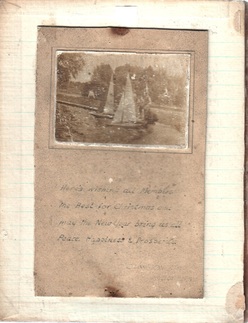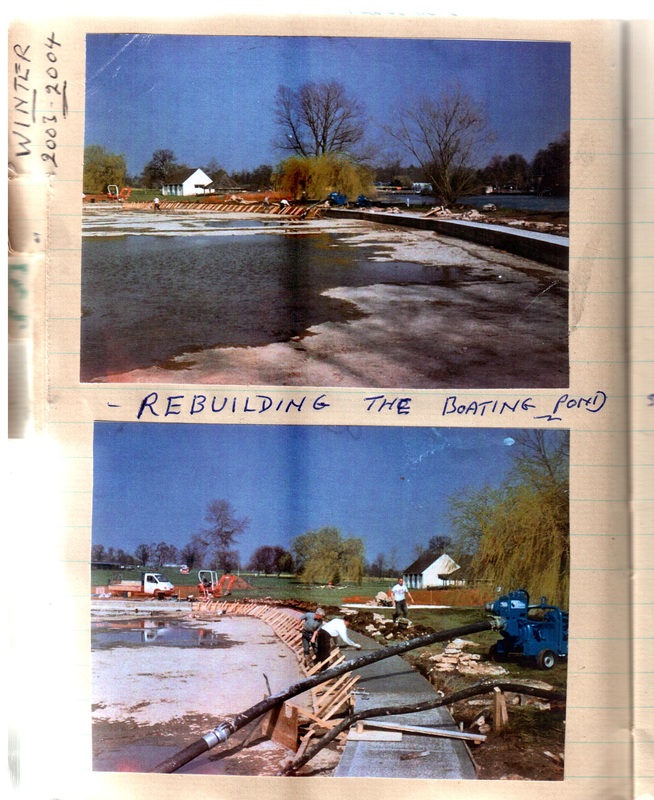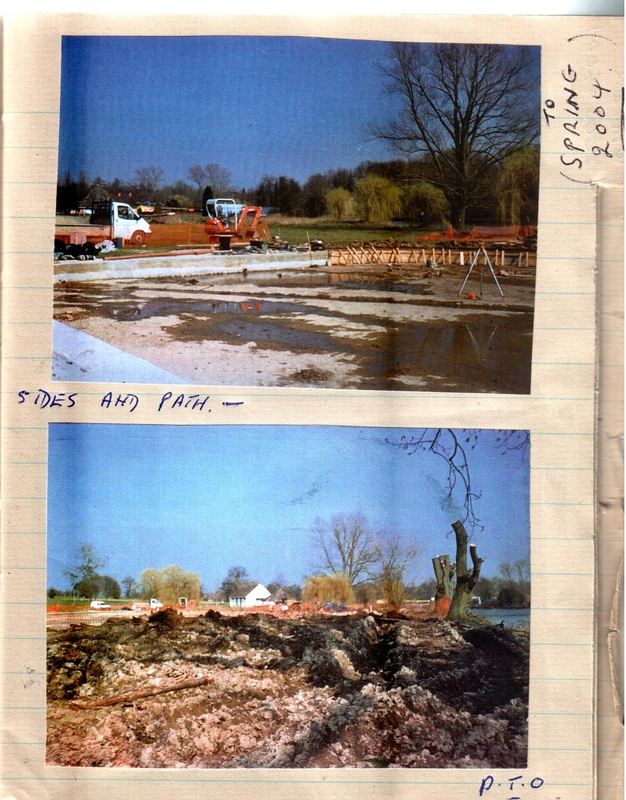The History Of Model Boating At Wicksteed Park
The following is a brief history of Boat Clubs at Wicksteed Park up to the 75th Anniversary in 1996 and was authored by Dennys Warren, a long standing member and former officer of the Club especially for that occasion.
He is also the owner of the collection of historic material relating to Boat Clubs at Wicksteed Park from which the accompanying pictures are drawn from.
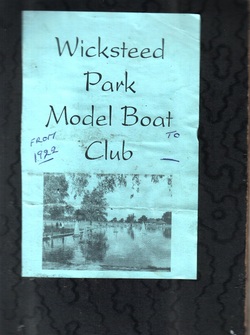
Talk to anyone of Wicksteed park, just outside Kettering, and the usual reply is that they remembered being taken there as a child on a day out, the rides, the swings, the slides, the trains and the lake with it's rowing boats
It was early 1921 that the large lake was finished and the park opened for the use of the children of Kettering. Travel to any park, not only in this country but most places in the world and the swings were made by Wicksteeds. On 12th February 1923 in the park pavilion a meeting, attended by a number of small boys, a lady and several men whose ages ranged from 17 to 40 and beyond, under the presidency of Mr T. Seddon MBE, met to form the Wicksteed Park Model Yacht Club.
It was early 1921 that the large lake was finished and the park opened for the use of the children of Kettering. Travel to any park, not only in this country but most places in the world and the swings were made by Wicksteeds. On 12th February 1923 in the park pavilion a meeting, attended by a number of small boys, a lady and several men whose ages ranged from 17 to 40 and beyond, under the presidency of Mr T. Seddon MBE, met to form the Wicksteed Park Model Yacht Club.
Opening the meeting, Mr Barnard, the sales manager of Bassett Lowke Models, spoke of the 2 objectives of a yachting club, amusement and instruction.
He also spoke of emulating the Seagraves and Kaye Dons of the boating world. Furthering the cause of science and comradeship engendered by the meeting of clubs in sailing and power competitions. It was at this meeting that it was suggested the word “powerboat" was added to the name.
The Club’s sailing activities at this time were on the main lake, which incidentally is only 24 to 33 inches deep, chest waders depth. This was put to the test at one regatta when a Bedford veteran, after a good lunch, apparently imagined he could walk across the lake to attend to his boat when he calmly stepped off the bank. Thanks to the Wicksteed drying room he was able to continue in dry clothing.
The high speed power boats of the time were all tethered , sailed by use of a tripod set in the lake in front of the club hut, which was shared with the Wicksteed Rowing Club. Even swimming was allowed at the time.
He also spoke of emulating the Seagraves and Kaye Dons of the boating world. Furthering the cause of science and comradeship engendered by the meeting of clubs in sailing and power competitions. It was at this meeting that it was suggested the word “powerboat" was added to the name.
The Club’s sailing activities at this time were on the main lake, which incidentally is only 24 to 33 inches deep, chest waders depth. This was put to the test at one regatta when a Bedford veteran, after a good lunch, apparently imagined he could walk across the lake to attend to his boat when he calmly stepped off the bank. Thanks to the Wicksteed drying room he was able to continue in dry clothing.
The high speed power boats of the time were all tethered , sailed by use of a tripod set in the lake in front of the club hut, which was shared with the Wicksteed Rowing Club. Even swimming was allowed at the time.

The next year a small pond 95yds x 40yds was built specially for the tethered boats, slowly becoming known as hydroplanes. Wicksteed Club’s first open regatta was held on Sunday 30th April 1933 at 10a.m. under the guidance of Mr Alan G Timpson of Timpson Engineering, after who the Club’s main trophy is still named.
In order to bring in the competitors, their assistants and craft, a special train was run from London, a lorry was supplied for the boats from the station to the park. About 50 people made use of this method of transit. In addition, other special buses came from Bedford, Cambridge, Highgate and Birmingham. The records show that spectators numbered, at one time, over 3000. If you know the pond, they must have stood at least 10 rows deep.
The fastest petrol boat of the day was owned by Mr Marechrell named “Old Bean IV” timed over the 500 yds at a phenomenal speed of 32 mph.
This was overshadowed by “Chattabox”, a steam driven hydroplane which held the world speed record for the distance at the time of 43 mph.
Steam faster than petrol? Well we are talking hand made engines, shop bought engines never came about until the forties.
Meanwhile, on the large lake, “A” class and 36” yachts sailing across the water aimed at space between two flags.
Footnote from the report of the regatta, apologies for absence were received from Colonel Dennistoun and the Countess of Canaervon. The social circles early model boating enthusiast used to travel in must have been fast.
This was overshadowed by “Chattabox”, a steam driven hydroplane which held the world speed record for the distance at the time of 43 mph.
Steam faster than petrol? Well we are talking hand made engines, shop bought engines never came about until the forties.
Meanwhile, on the large lake, “A” class and 36” yachts sailing across the water aimed at space between two flags.
Footnote from the report of the regatta, apologies for absence were received from Colonel Dennistoun and the Countess of Canaervon. The social circles early model boating enthusiast used to travel in must have been fast.
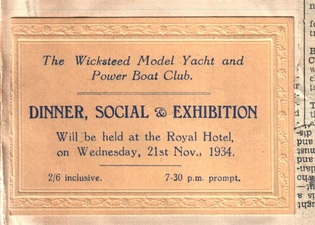
After the next few years, Wicksteed was the place where ‘Betty’ was always a welcome visitor with her companions, the innocent brothers who were always dressed in trilby hats complete with jackets, collar and tie, even when racing, proper dress was observed.
“Ifit.IV” (If it starts) skipper Mr A.W. Cockman was always among the visitors, the list of competitors and their boats would fill a book. With the support of the Wicksteed Park trustees, the club thrived.
Even the dinner and social evenings were very well attended. At the November dinner of 1935 they even had their own song of nine verses, some even repeatable.
“Ifit.IV” (If it starts) skipper Mr A.W. Cockman was always among the visitors, the list of competitors and their boats would fill a book. With the support of the Wicksteed Park trustees, the club thrived.
Even the dinner and social evenings were very well attended. At the November dinner of 1935 they even had their own song of nine verses, some even repeatable.

The club even invited the French Parisiene powerboat world champion, Mr Suzor, to visit.
Steering events (straight running) were first included in the 1936 June regatta.
Sunday 6th Sept. 1936 was the first time the fair sex were allowed to compete with 36” yachts. The Wicksteed club fixture list still includes a ladies event – “The Bikini Trophy”. These days it is sailed with “M” class.
The club details from 1940 to 1945 are very blank, but boats, both yacht and power were sailed as club records proved, along with news of a copy of a letter from H.R.H. Duke of Edinburgh declaring his patronage to the M.Y.A.. This copy still has pride of place in the club hut.
Steering events (straight running) were first included in the 1936 June regatta.
Sunday 6th Sept. 1936 was the first time the fair sex were allowed to compete with 36” yachts. The Wicksteed club fixture list still includes a ladies event – “The Bikini Trophy”. These days it is sailed with “M” class.
The club details from 1940 to 1945 are very blank, but boats, both yacht and power were sailed as club records proved, along with news of a copy of a letter from H.R.H. Duke of Edinburgh declaring his patronage to the M.Y.A.. This copy still has pride of place in the club hut.
An upsurge of the power boat section came in 1968 with the onset of radio equipment.
By this time, the Bedford club had merged in with the Wicksteed Club.
The first radio regatta was held in 1969 with boats competing singly on a set course (no multi crystals in the radios in those days), pairs racing came later.
Those were the days of the Blacknells and the Scarnells boats reaching the breathtaking 95 to 100 mph.
By this time, the Bedford club had merged in with the Wicksteed Club.
The first radio regatta was held in 1969 with boats competing singly on a set course (no multi crystals in the radios in those days), pairs racing came later.
Those were the days of the Blacknells and the Scarnells boats reaching the breathtaking 95 to 100 mph.
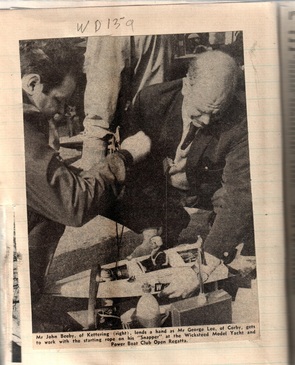
An upsurge of the power boat section came in 1968 with the onset of radio equipment
By this time, the Bedford Club had merged in with the Wicksteed Club.
The first radio regatta was held in 1969 with boats competing singly on a set course (no multi crystals in the radios in those days), pairs racing came later.
Those were the days of the Blacknells and the Scarnells boats reaching the breathtaking 95 to 100 mph.
By this time, the Bedford Club had merged in with the Wicksteed Club.
The first radio regatta was held in 1969 with boats competing singly on a set course (no multi crystals in the radios in those days), pairs racing came later.
Those were the days of the Blacknells and the Scarnells boats reaching the breathtaking 95 to 100 mph.
These were the heydays of the club before the Wicksteed safety policies deemed the pond as not suitable for craft of that speed, unless crash barriers were fitted both in the water and all around the bank. This proved to be unpracticable as it would restrict the access to the pond. Therefore RTP and straight running regattas were shelved and yachts again reigned supreme.
The club today is encouraging R/C electrics and scale boats although the Wicksteed sailing water has changed very little since it was first built. The progress of the quality of boats sailed has changed greatly. From hand engineered to shop bought boats, speeds are faster but not so spectacular.
The club still retains vane sailing alongside radio control classes, both enjoyed by all.
The club today is encouraging R/C electrics and scale boats although the Wicksteed sailing water has changed very little since it was first built. The progress of the quality of boats sailed has changed greatly. From hand engineered to shop bought boats, speeds are faster but not so spectacular.
The club still retains vane sailing alongside radio control classes, both enjoyed by all.
The End, Well not quite.
I have added eight more pictures below that were taken at the time of the redevelopment of the lake over the period of the Winter 2013 to the Spring of 2014. They are again part of Dennys Warren's collection.
If anyone reading this article has any pictures that would help trace the life of the Model Boat Club at Wicksteed Park and would like them added to the History then please send them to me with a short description on the content.
If anyone reading this article has any pictures that would help trace the life of the Model Boat Club at Wicksteed Park and would like them added to the History then please send them to me with a short description on the content.
